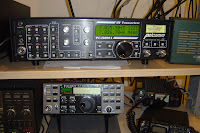What is CW?
CW is sending Morse code, yes those dits and dashes you learned in Boy Scouts, over the radio in a continuous wave mode, hence the abbreviation CW. It used to be widely used in maritime, military and railroad communications. It's a highly efficent, highly effective way to communicate. You can communicate farther, with less power and a more simple radio, than in most other modes. A lot of the arcane phrases and abbreviations in Ham radio stem from its roots in telegraphy. Long before kids were texting short messages, telegraphers were figuring out abbreviations. Some of these are being picked up by the texters today, some not. An unmarried woman is a YL, short for Young Lady. When she gets married, she becomes an XYL, ex-young lady. My wife doesn't like that phrase, she still thinks of herself as a YL. CQ is a call you put out when you are looking for someone to talk to. I will send CQ several times followed by my call, K9OZ. Someone hearing that, knows I'm looking for a cha




